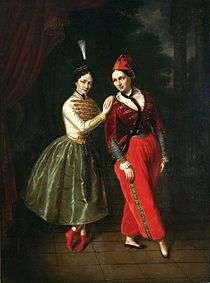Le Diable amoureux (ballet)

Pauline Leroux in Act III of Le Diable Amoureux
Le Diable amoureux (also known as Satanella or Love and Hell) is a ballet pantomime in three acts and eight scenes, originally choreographed by Joseph Mazilier to the music of Napoléon Henri Reber and François Benoist. The libretto by Jules-Henri Vernoy de Saint-Georges is based on Jacques Cazotte's 1772 occult romance The Devil in Love. The work was first presented by the Ballet du Théâtre de l'Académie Royale de Musique in Paris on 23 September 1840, with Pauline Leroux (as Uriel), Mazilier (as Alvaro, for ballet his name is Frederic), and Louise Fitz-James (as Lilia).[1]
Revivals

The Strauss sisters, Leila and Asmodée, 1853, by Jan Ksawery Kaniewski
- Revival by Marius Petipa and Jean Antoine Petipa for the Imperial Ballet under the title Satanella, with music orchestrated and revised by Aleksandr Liadov (mistake in sources: Konstantin Liadov). First presented on 22 February [O.S. 10 February] 1848 at the Imperial Bolshoi Kamenny Theatre, St. Petersburg, Russian Empire. Principal Dancers: Yelena Andreyanova as Satanella, and Marius Petipa as Count Fabio.
- Revival by Marius Petipa for the Imperial Ballet with additional music by Cesare Pugni. First presented on 30 October [O.S. 18 October] 1866 at the Imperial Bolshoi Kamenny Theatre, St. Petersburg, Russian Empire. Principal Dancers:Praskovia Lebedeva as Satanella, and Lev Ivanov as Count Fabio.
- Revival by Marius Petipa for the Imperial Ballet with additional music by Cesare Pugni. First presented on 7 May [O.S. 25 April] 1868 at the Imperial Bolshoi Kamenny Theatre, St. Petersburg, Russian Empire. Principal Dancers: Alexandra Vergina as Satanella, and Lev Ivanov as Count Fabio.
- Revival of Marius Petipa by Ivan Chliustin (ru: И. Н. Хлюстин) & Nicola Domashov (ru: Н. П. Домашёв) for the Imperial Ballet. First presented on 18 February [O.S. 6 February] 1897 at the Bolshoi Theatre in Moscow. Principal Dancers: Lyubov Roslavleva.
Notes
References
- Garafola, Lynn / Petipa, Marius. The Diaries of Marius Petipa. Trans, Ed., and introduction by Lynn Garafola. Published in Studies in Dance History. 3.1 (Spring 1992).
This article is issued from
Wikipedia.
The text is licensed under Creative Commons - Attribution - Sharealike.
Additional terms may apply for the media files.